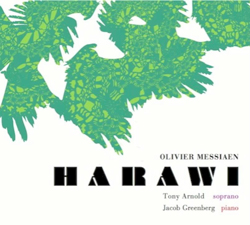by Daniel Hautzinger

He was synesthetic, so that he heard chords as colors. And he originated total serialism, where pitches and rhythms are standardized, so that a specific note will always have the same articulation and duration in a piece. Serialism became the predominant compositional method during the 1950s. It is some of the most difficult and maligned music existent, but Messiaen’s use of it is comprehensible and attractive.
The solo piano piece Cantéyodjayâ (1949), with which pianist Jacob Greenberg opens his and soprano Tony Arnold’s excellent new CD of the song cycle Harawi (New Focus Recordings), is a case in point. Despite containing a section of serialized rhythm (one of the first pieces to do so), it grooves. Greenberg deploys a wide variety of sounds and attacks in episodes sandwiched between the refrain of a demented melody over a spasmodic rhythm.
And then comes Harawi (1945), a twelve song, nearly hour-long cycle inspired by Peruvian love songs and the myth of Tristan and Isolde. Arnold and Greenberg deserve commendation just for learning the work, with its scattershot, percussive piano parts, challenging vocal lines, and demand for both lyricism and violence.
The mystical text is by Messiaen himself and based in his idiosyncratic faith. Consisting of two lovers’ professions of devotion and their acceptance of an unknown death, it chains together ecstatic images, colors, and onomatopoetic utterances; love, nature, and the sacred mingle to become a final, transcendent power.
What is the music for such a text like? Rapturous, profane, caressing, clamorous, beatific, or simply mind-blowing. Like in Cantéyodjayâ, there is a strong rhythmic element. Many of the vocal melodies are surprisingly simple (though that doesn’t mean easy to sing), especially in comparison to the often crazed piano parts surrounding them. A common structure alternates tranquil melodies with frenetic, harsh piano interludes, brilliantly executed by Greenberg. Many of the songs are orgiastic dances with almost jazzy rhythms and frenzied singing, like “Syllabes” (“Syllables”) and “L’Escailer redit, gestes du soleil” (“The Staircase Retold, Gestures of the Sun”).
Part of the work’s power comes from its juxtaposition of aggressiveness and quiet adoration. For instance, rhapsodic, dissonant curlicues on the piano evoke the harsh cries and flight of a bird over sweet chords in “Bonjour toi, colombe verte” (“Hello there, you green dove”). This tension is especially apparent in the varieties of singing. Arnold forcefully declaims her text in the chaotic “Montagnes” (“Mountains”), ominously chants it in the ritualistic dance of “Dondou Tchil,” and immediately afterward serenades her lover in the naïve “L’amour de Piroutcha” (“Piroutcha’s Love”). At other points she screams, ululates, and rages, then unspools a gorgeous tone.
One hymn-like theme recurs multiple times over resoundingly tonal chords, contented and loving. Each time, Arnold and Greenberg imbue it with both tenderness and understated strength. In “Adieu” (“Farewell”), the center of the cycle, they slowly allow it to become wildly impassioned. When it returns a final time in the last song “Dans le noir” (“In the dark”), that pain is gone, and the piano traces starry constellations that slowly descend through the chorale, the lovers merging with the earth and relaxing into eternal peace.
Published on ClevelandClassical.com January 30, 2014
Click here for a printable version of this article.



